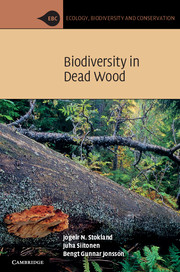Book contents
- Frontmatter
- Contents
- Preface
- 1 Introduction
- 2 Wood decomposition
- 3 The saproxylic food web
- 4 Other associations with dead woody material
- 5 Host-tree associations
- 6 Mortality factors and decay succession
- 7 Microhabitats
- 8 Tree size
- 9 The surrounding environment
- 10 Evolution of saproxylic organisms
- 11 Species diversity of saproxylic organisms
- 12 Natural forest dynamics
- 13 Dead wood and sustainable forest management
- 14 Population dynamics and evolutionary strategies
- 15 Threatened saproxylic species
- 16 Dead wood in agricultural and urban habitats
- 17 The value and future of saproxylic diversity
- References
- Index
9 - The surrounding environment
Published online by Cambridge University Press: 05 June 2012
- Frontmatter
- Contents
- Preface
- 1 Introduction
- 2 Wood decomposition
- 3 The saproxylic food web
- 4 Other associations with dead woody material
- 5 Host-tree associations
- 6 Mortality factors and decay succession
- 7 Microhabitats
- 8 Tree size
- 9 The surrounding environment
- 10 Evolution of saproxylic organisms
- 11 Species diversity of saproxylic organisms
- 12 Natural forest dynamics
- 13 Dead wood and sustainable forest management
- 14 Population dynamics and evolutionary strategies
- 15 Threatened saproxylic species
- 16 Dead wood in agricultural and urban habitats
- 17 The value and future of saproxylic diversity
- References
- Index
Summary
The surrounding environment strongly influences the conditions inside the wood and is fundamental to determining whether a saproxylic species is able to utilize a certain piece of dead wood. Many species show a clear preference for wood in sun-exposed and dry habitats, while others prefer shady and moist conditions. The tree’s position, whether it is standing or lying, also determines the degree of sun exposure, temperature and moisture in the wood. In addition, the species composition varies according to the surrounding medium. In terrestrial habitats, the vast majority of species utilize the above-ground wood, although some species are specialized to use dead roots buried in the soil. Other species only utilize submerged wood from trees that have fallen into rivers or lakes, and yet others occur on wood in marine waters. In addition, man-made wooden constructions create opportunities for saproxylic species. When these species occur inside houses, they can attack and severely damage the wooden construction materials (see Box 9.1).
In addition to the direct effects, the surrounding environment also has an indirect effect on dead wood through the conditions experienced by the living tree. The local conditions determine the annual growth increment and wood density, and events such as physical injury and insect attacks affect the chemical characteristics of the wood. These wood properties may strongly influence the saproxylic species that later utilize the dead tree. Some of these aspects have partly been addressed in Chapter 6, but deserve some additional attention in this chapter.
- Type
- Chapter
- Information
- Biodiversity in Dead Wood , pp. 194 - 217Publisher: Cambridge University PressPrint publication year: 2012
- 3
- Cited by



